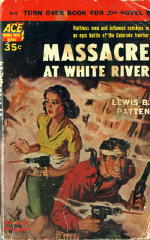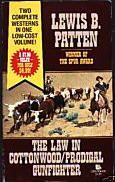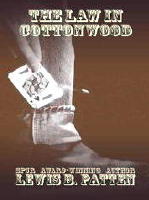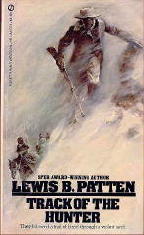Sat 6 Sep 2008
Western Review: LEWIS B. PATTEN – Prodigal Gunfighter.
Posted by Steve under Pulp Fiction , Reviews , Western Fiction[8] Comments
LEWIS B. PATTEN – Prodigal Gunfighter.
Berkley F1241; paperback original, 1966. Signet, 1976; Signet Double, 1979; Leisure Double, 1994.

Lewis B. Patten’s first book, Massacre at White River, came out from Ace in 1952, and his writing career continued right up until he died in 1981, when Track of the Hunter came out, also as a paperback original, this time from Signet.
He was incredibly prolific. In a thirty-year span he produced something like 90 novels, including books as by Lewis Ford, Len Leighton (with Wayne D. Overholser) and Joseph Wayne (also in collaboration with Overholser).
As one of the next generation of western writers, Patten’s all of novels came out very much in the post-pulp era but (as far as I know) also still all very much in the “code of the west” tradition. It’s certainly difficult to generalize on the basis of one book, and Prodigal Gunfighter is the only book of his that I’ve read in several years, and probably more than that.
Not that Patten didn’t write for the pulps. Starting in 1950 he had a score or more shorter works that appeared in magazines like Mammoth Western, Thrilling Western, Frontier Stories and so on. His name is certainly more identified with novels, however, and in his heyday, he was cranking them out like almost nobody else.
And he was published in hardcover as well. He may have begun in softcover only, but beginning with Guns at Gray Butte in 1963, more and more of books came out from Doubleday. Not all of them, but a high percentage of them, the easy explanation for this being that he probably wrote more books than Doubleday could publish.
Take 1966 for example. He wrote No God in Saguaro and Death Waited at Rialto Creek for Doubleday; The Odds Against Circle L for Ace; and Prodigal Gunfighter for Berkley. Not that year, but in the same time period, he also wrote for Lancer and Signet, the latter eventually becoming his primary publisher in paperback, both for originals and reprints of the Doubleday novels.

If you want a slim and lean western to read, one that you will pick up and not put down until you’re done, then the 128 page Prodigal Gunfighter is the book for you. Taking place in the space of only a day in the small town of Cottonwood Springs, Patten certainly doesn’t leave the reader much time to breathe.
The early morning finds the entire town down at the railroad station, waiting for the prodigal to return, in the person of the notorious home-grown gunfighter Slade Teplin. Included among them is a rather nervous deputy sheriff Johnny Yoder, who has been semi-courting Teplin’s wife, Molly, a school teacher who thought she could tame him, couldn’t, but who has not yet divorced him.
Is he the reason for Slade’s return? Slade has had no contact with Molly since he left town. His father still lives in Cottonwood Springs, but there’s hardly any love lost between the two of them. Does he want revenge of some sort against the entire town? It is pure hatred? No one seems to know, and the sense of fear in the town is everywhere.
And no one can do anything, including the law. In all but his first of many killings over the years, Slade has never drawn first. On page 91 Slade is briefly confronted by the sheriff:
“I always let the other guy draw first.”
“Sure. Sure you do. You can afford to. Besides, it’s smart. It gives you immunity from prosecution. But you know, every time who it is that’s going to die. Like with Cal Reeder earlier today.”

Cal Reeder was a kid, the son of a wealthy local rancher, who thought he’d make a name for himself and failed. His father is part of the story, and so are the four drifters that Johnny notices having come quietly into town.
Even at the short length the plot does not go exactly where it seems expected to do, and on pages 114-115 is one of the best choreographed fist-fights (not shoot-outs) I’ve read in quite a while, and it’s not even with Slade Teplin. He’s still on the loose, however – don’t worry about that – and with plans to cause even more havoc in Cottonwood Springs.
To show you want I mean, though, here’s at least how the end of the fight reads:
But he lacked one thing, one thing that Johnny had – anger, righteous indignation and outraged fury. Johnny had those things in quantity. For every blow the stranger struck, Johnny retaliated with another, harder one.
The man was weakening. They rolled against the glass-strewn floor to the window and back again. And at last Johnny felt the man go limp.
After a few seconds taken to recover, Johnny knows he needs to make the man talk. From page 116:

He’s not bluffing. The west was a tough place to live, but Patten’s characters also seem to be tough enough themselves and equal to the challenge when they need to be. What’s more traditional than that?
PostScript: Written later in Patten’s career is a book called The Law in Cottonwood (Doubleday, 1978). In paperback form from Signet and Leisure, it eventually appears packaged up in the same edition as Prodigal Gunfighter, two novels for the price of one. I don’t happen to have a copy readily at hand, so while I’m curious and it may not be very likely, I have no idea whether or not the later book has any of the same characters as this one.
[UPDATE] 09-06-08. First of all, my apologies for being unable to provide a cover image for the original Berkley edition of this book. I can’t get at my copy, and I can’t locate one anywhere else. There is only one copy for sale on abebooks at the moment, for example. Early Berkley paperbacks are often hard to find, more so than you might think, but their distribution through the 1960s was extremely erratic. (Believe it or not, I was looking for them then.)
I posted this to fulfill a semi-promise I made in the previous post, in which Patten came up as an example of western noir writer. I didn’t write this review with that thought in mind, but at least from the quotes, I think you can gather that it’s a fairly tough-minded book. More than that I cannot tell you myself.
September 6th, 2008 at 6:12 pm
Steve: I believe “The Law at Cottonwood” dealt with a Marshal trying to keep a town held together after a bunch of hungry cowboys ride in wanting a whole lot-a-fun. The town is Cottonwood Kansas, and the Marshal basically takes them on alone. I remember it was a damn good one, equal to the author’s “A Killing in Kiowa” which dealt with a Sheriff trying to do what is right after a group of local town boys rape and murder a saloon whore.
Both I enjoyed, as I do most Lewis Patten Westerns. The stories were about little episodes in a man’s or a town’s life, like you said just a few days. Law and lawlessness, right and wrong. One of my favorite Western authors. I enjoy the postings you have on him.
September 6th, 2008 at 6:49 pm
Nothing in common for the two books but the name, then, that and a few days of significance in the life of a town. I can accept that.
From Wikipedia: The plains cottonwood is the state tree of Nebraska, Wyoming and Kansas. Cottonwood is one of the poorest woods to use as wood fuel. It does not dry well, and rots quickly. It splits poorly, because it is very fibrous.
September 6th, 2008 at 7:10 pm
Steve: Thanks for the tip that Joseph Wayne was a pseud. used by Lewis Patten. (I never knew)I have a few ACE Westerns by Joseph Wayne that I never read. Will now!
September 6th, 2008 at 11:06 pm
Steve
Looks like between us and James we’ve sparked off a mini Lewis B. Patten revival!
When I learn of the umpteenth printings of other western novels of the period, I often wonder why it has never happened before. To my mind, Patten’s typical story is far more likely to appeal immediately to a modern reader.
Keith
September 6th, 2008 at 11:32 pm
I’ve just checked on bookfinder.com. I came up with 46 Patten books listed as new. I didn’t take the time to investigate further, but most of these are going to be Five Star and large-print editions.
Which means that 99% of them are being sold to libraries, but even so, it certainly proves your point, Keith. Patten’s books are still being read today.
— Steve
September 7th, 2008 at 2:28 am
There are two big books on western authors that I’m always reading and paging through. Lewis B. Patten has fairly large entries in both these books:
Twentieth Century Western Writers edited by James Vinson, publisher Gale Research Co.(1982). There also is a second edition published by St. James but I prefer the first edition’s size and format by Gale. It’s over 900 pages.
Encyclopedia of Frontier & Western Fiction by Jon Tuska and Vicki Piekarski, publisher McGraw-Hill(1983). 365 pages.
Both books are out of print but should be available on Abebooks.com or bookfinder.com. I recommend them highly.
September 30th, 2008 at 1:45 pm
[…] My review of Prodigal Gunfighter on these pages a short while ago was preceded by a post on Western Noir in which Patten’s name came up in a major way. Both of these posts elicited a substantial number of comments, showing that Patten, for one, is a western author still being read, in spite of his death in 1981, and that the concept of noir and western fiction are not in the least way incompatible. […]
May 8th, 2011 at 4:48 pm
Just finished my first but not last book by Lewis…Bones of the Buffalo.
I felt I was there.